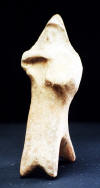

Click on links for information on Parthian statues:
The necropolis at Nisa has yielded fragments of larger than life size statues, leading Frye [Heritage (1963), p. 174-175] to suppose there was a cult of dead Parthian kings. He adds that the discovery of similar fragments in Toprak Kale, and the Kushan sanctuary of Surkh Kotal plus the statues of Nimrud Dagh and Shami support the existence of a cult of the heroicised dead king. |
|
| Male statue from Shami (Khuzistan, South-western Iran); head of bronze statue of Parthian prince; 1st or 2nd century A.D. | |
| Portrait head of a king from Shami (Khuzistan, South-western Iran); Parthian period, 2nd half of the 2nd century B.C., bronze. Teheran, National Museum (image here from the temporary exhibition 7000 Years of Persian Art organized by the Kunsthistorisches Museum, Vienna, November 22, 2000 - April 16, 2001) | |
| Standing man, 1st–2nd century A.D.; Parthian period. Iran. Gray stone; H. 76.8 cm. | |
| Door lintel with lion-griffins and vase with lotus leaf, 2nd–3rd century; Parthian period. Hatra, northern Mesopotamia. Limestone; L. 172.1 cm. (New York: Metropolitan Museum of Art) | |
| Figure of a reclining woman, 2nd century B.C.–2nd century A.D.; Parthian period Mesopotamia. Alabaster (gypsum); L. 7.3 cm. (New York: Metropolitan Museum of Art) |
|
| Spout in the shape of a man's head, 1st–2nd century A.D.; Parthian period. Iran. Glazed ceramic; H. 20.9 cm. (New York: Metropolitan Museum of Art) | |
| Standing woman, 2nd century B.C.–3rd century A.D.; Parthian period. Possibly Ctesiphon, Mesopotamia. Alabaster; H. 27 cm. (New York: Metropolitan Museum of Art) | |
| Palmyrene funerary monument, showing strong Parthian influence, especially in the garments. In the Metropolitan Museum collection, New York | |
 Terracotta figurine, rider on horseback, 94 mm height. Private collection. Terracotta figurine, rider on horseback, 94 mm height. Private collection. |
|
 Female statue with a flowing gown, headdress, and jewels, showing Parthian fashion of 2nd century A.D. Female statue with a flowing gown, headdress, and jewels, showing Parthian fashion of 2nd century A.D. |
This page last updated 23 Feb 2021